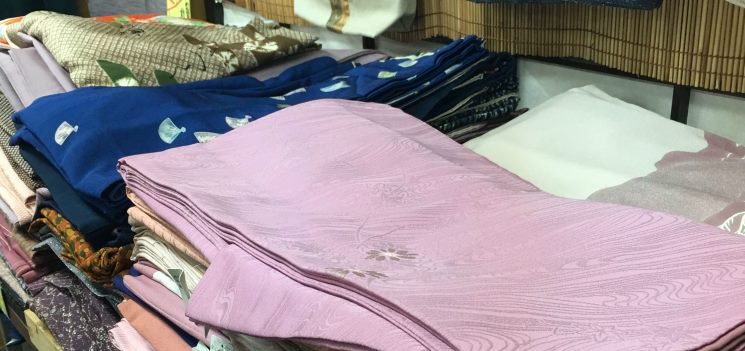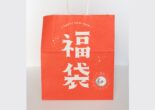
A Glimpse into the World of the Japanese (Secondhand) Kimono
Shitamachi Omoshiro Kogeikan is a little shop on the ground floor hidden in an unimposing building that is tucked between a French restaurant and a bar. You will most likely just pass by and wonder about the little French restaurant where people start queuing before it even opened. But then, this is Tokyo and people always queue. Maybe you would miss the entrance to the Kogeikan entirely you weren’t able to spot the Japanese sign. But once you made up your mind and step inside, you will be welcomed into the world of a very diverse aspect of Japanese culture – the world of the Japanese Kimono.
The Kogeikan located just 2 minutes from Ningyocho Station is a place for like-minded Kimono enthusiasts. The shop is most famous for its Second Hand Kimonos and accessories as well as its Kimono classes run by knowledgeable and experienced volunteers. You will also be able to find some nice traditional and handmade souvenirs such as Washi paper postcards but the focus is clearly on the Kimono.
Many tourists and foreigners think about buying a Kimono as a souvenir or simply to wear it for special occasions and seasons but not few of them will be shocked when they see the price tag. Buying a new Kimono can be quite a financial stretch and can cost you easily around 200,000 Yen. Because in the end, you won’t just need the beautiful Kimono but everything that is holding it together. This includes the Nagajuban (the inner Kimono), the Kimono itself, the Obi (belt), the Obiage (a piece of silk crepe that is often visible above the Obi), the Obijime (the decorative binding over the Obi), Tabi, Geta/Zori, endless corts, proper Kimono underwear and maybe a Kimono jacket. Many Japanese women inherit their Kimono from their mothers and grandmothers and buy their own first Kimono after they got married. Therefore, buying a secondhand Kimono or a recycle Kimono can be a much better and cheaper solution for people who want to “try it out” first or want to buy several Kimonos for many different occasions. The knowledgeable staff working at Kogeikan such as Mr Konishi can help you to find the Kimono that is just right for you without bringing a financial crisis upon you. Secondhand Kimonos already start at 1,000 Yen (~10 USD) and the Kogeikan also offers other necessary items such as Obi, Obijime, Obiage and Zori. Don’t be surprised but the Obi might be a lot more expensive than the actual Kimono.
 Just acquiring all the necessary items for your Japanese Kimono doesn’t do the trick however. You have to be able to put it on as well and it gets really frustrating when you hear that even Japanese women don’t know how to do it nowadays. In a time where you might have an occasion about once or twice a year to put your Kimono on, people just forget it if they don’t practice it regularly. This is where the lovely people at Kogeikan step in.
Just acquiring all the necessary items for your Japanese Kimono doesn’t do the trick however. You have to be able to put it on as well and it gets really frustrating when you hear that even Japanese women don’t know how to do it nowadays. In a time where you might have an occasion about once or twice a year to put your Kimono on, people just forget it if they don’t practice it regularly. This is where the lovely people at Kogeikan step in.
They offer classes on a monthly basis to teach you how to put on your Kimono as well as guide you on the big do’s and don’ts regarding colors, seasons, occasions etc. Where other classes can be quite expensive, the teachers at Kogeikan do it as a voluntary act and thus the classes are for free.
I was able to witness such a class and I was deeply impressed by the teacher as well as by the participants. Women of all age were participating – from 30 to 70 years old. Everyone brought their own Kimono and other necessary items as well as a collection of Obijime and Obiage. Most of these women already knew how to put on a Kimono – technically – but as Mr. Konishi told me, if you don’t practice it on a regular basis, you simply forget the steps and end up in a Kimono that doesn’t look quite right. Especially the binding of the Obi can be quite challenging and so this part can be repeated several times during the class. I talked with several of those young women and they said that they wished to wear the Kimono more often for occasions such as a fancy dinner or a visit to a Kabuki theater. The experienced Kimono teacher does not wear a Kimono every day herself but adding with a smile “not everyday but nearly everyday”. I was especially flabbergasted by all the rules and combinations. For certain seasons and occasions you got to wear certain Kimonos and colors. Some Kimono can be worn throughout the whole year but you transform it into a winter Kimono by choosing specific winter colors for the Obiage and Obijime. I witnessed lengthy discussions about the fitting colors during the class and could not understand how the colors were chosen. Colors I thought were clearly happy summer colors were actually winter colors. A certain Obi was appropriate for a Kabuki visit on New Year’s day (still winter) but with a certain Obiage it would give the impression that spring is round the corner. A white Kimono and a white Obi were something of a no-go in the past but have apparently become something of a new trend and is thus very fitting for modern and stylish young Kimono lovers.

Secondhand Kimonos
I learned so much and felt all the more confused at the end. I even got the chance to try on a Kimono myself but needless to say, I didn’t have the tiniest clue and the teacher basically dressed me. The whole process can take up to an hour. There were certain movements I had to repeat over and over again with my arms that did not make any sense to me but were apparently very important for putting on the Kimono. I tied countless ribbons around my waist and tucked here and there and after an hour I was finally wearing a Kimono (but a slightly reduced form as I wasn’t wearing a Nagajuban).
Why are the classes for free when other places take a lot of money? The Kogeikan is not primarily a Kimono school but a shop selling recycled Kimono, Kimono accessories and other crafts. Many of the women that frequently come will at some point buy a new Obi or other accessories. Some bring in their old Kimono for repair. Through all these services centered around the Kimono, the little shop is able to provide free classes.
Observing all those women I wondered how long it actually takes for a complete beginner to master the art of putting on the Kimono all by oneself. Mr Konishi smiled and said it should take about three classes. I somehow doubt that but maybe I should try my luck.
I can only recommend everyone to pay a visit to the small shop. The free class is held once a month and you should contact them in advance about being interested.
Shitamachi Omoshiro Kogeikan
Address: 2 Chome-2-6 Nihonbashiningyōchō, Chūō-ku, Tōkyō-to 103-0013
Opening Hours: 10:00 – 19:00, Mon – Sun
Closed: Every 2nd and 4th Thursday, end of the year holidays, Obon
Telephone: 03-3664-3780
Email: [email protected]
Homepage (jp.): http://www.matae.com/
Kimono Classes: http://www.matae.com/kitsuke/

Obijime and Obiage
Related Articles
Warning: Undefined array key "sfsi_threadsIcon_order" in /home/veremosglobal/tokyoroomfinder.com/public_html/blog/wp-content/plugins/ultimate-social-media-icons/libs/controllers/sfsi_frontpopUp.php on line 165
Warning: Undefined array key "sfsi_blueskyIcon_order" in /home/veremosglobal/tokyoroomfinder.com/public_html/blog/wp-content/plugins/ultimate-social-media-icons/libs/controllers/sfsi_frontpopUp.php on line 170
Warning: Undefined array key "sfsi_bluesky_display" in /home/veremosglobal/tokyoroomfinder.com/public_html/blog/wp-content/plugins/ultimate-social-media-icons/libs/controllers/sfsi_frontpopUp.php on line 266



